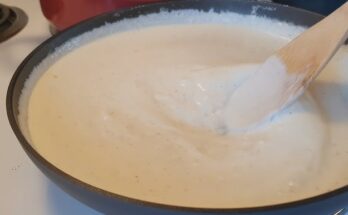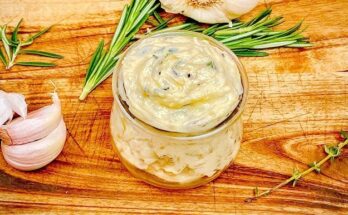Yellowfin Tuna Recipe: Yellowfin tuna, often known as ahi, is a meaty, flavorful fish that holds up well to high heat cooking, making it perfect for grilling, searing, or baking. If you’ve ever had a perfectly seared tuna steak at a fancy restaurant and thought, “There’s no way I can make this at home,”—you’re in for a pleasant surprise. Cooking yellowfin tuna isn’t just doable in your own kitchen; it’s actually quite simple and rewarding.
This guide is your all-in-one roadmap to cooking restaurant-quality yellowfin tuna at home. From choosing the freshest cut at the fish market to seasoning and searing it just right, I’ll walk you through everything. Ready to bring the taste of the sea to your table?
Why Choose Yellowfin Tuna?
Yellowfin tuna isn’t your average fish. It has a rich, meaty texture that sets it apart from flaky white fish like cod or tilapia. This makes it ideal for dishes where you want the fish to hold its shape and soak up a marinade. It’s firm, but not tough—think of it as the steak of the sea.
The flavor? Mildly sweet with a slightly nutty finish, and it doesn’t have the overpowering “fishy” taste that turns many people off seafood. It pairs well with a wide variety of flavors—from citrus and soy to chili and herbs.
Yellowfin tuna is also sustainable if sourced responsibly. It’s available fresh or frozen in most fish markets and supermarkets, and best of all, it cooks quickly. That makes it a great protein choice for busy weeknight dinners and special occasions alike.
Health Benefits of Yellowfin Tuna
You’re not just getting a delicious dinner when you cook yellowfin tuna—you’re giving your body a nutrient-dense, lean source of protein. Yellowfin is packed with omega-3 fatty acids, which are known to reduce inflammation and support heart and brain health.
Here are a few health perks you get from every serving:
- High in Protein: Around 25 grams of protein per 3-ounce serving.
- Rich in Omega-3s: Promotes heart health and reduces bad cholesterol.
- Low in Calories and Fat: Great for those watching weight.
- Loaded with Vitamins & Minerals: Including Vitamin B12, Vitamin D, and selenium.
But like all fish, it’s essential to monitor mercury levels—especially for pregnant women or young children. Moderation is key.
Different Cooking Methods for Yellowfin Tuna
Depending on your preference, yellowfin tuna can be prepared in a variety of ways. Here are some popular cooking methods:
Grilling
Grilling gives yellowfin tuna a slightly smoky flavor and beautiful char marks. It’s perfect for summer cookouts and outdoor gatherings.
Seared (Pan-Seared)
Seared tuna, often left rare in the center, is one of the most popular ways to enjoy this fish. It’s quick, elegant, and great for showcasing the natural flavor of the tuna.
Baking
Oven baking is a more hands-off approach. It’s a good method if you’re cooking for a crowd or want a more well-done tuna.
Sous Vide
Sous vide allows precise control over the tuna’s doneness and texture. Finish with a quick sear for a professional touch.
Things to Know Before Cooking Yellowfin Tuna
Before you fire up your stove or grill, there are a few things you should know:
- Tuna cooks FAST. Overcooking can make it dry and chalky.
- Thickness matters. Thicker steaks (at least 1 inch) are easier to cook to the desired doneness.
- Resting is key. Let it rest for a few minutes post-cooking to lock in the juices.
- Searing keeps it rare inside. That’s the traditional way—think steak tartare’s cooked cousin.
How to Buy Fresh Yellowfin Tuna
When shopping for yellowfin tuna, here’s what to look for:
- Color: Fresh tuna is bright red to deep cherry. Avoid brown or dull-colored fish.
- Smell: It should smell like the ocean, not “fishy.”
- Texture: It should be firm and not mushy when touched.
- Source: Look for responsibly caught, sushi-grade or sashimi-grade tuna if you want to cook it rare.
Essential Kitchen Tools You’ll Need
Make sure you have the right gear to make your tuna-cooking experience smooth:
- Cast iron skillet or grill pan
- Tongs or fish spatula
- Mixing bowl for marinade
- Sharp knife for slicing
- Cutting board
- Meat thermometer (optional but helpful)
Ingredients You’ll Need
Let’s break down what you’ll need for a basic grilled or seared yellowfin tuna steak.
For Basic Grilled Yellowfin Tuna:
- 2 yellowfin tuna steaks (6-8 oz each, 1-inch thick)
- 2 tablespoons olive oil
- 1 tablespoon soy sauce
- 1 tablespoon lemon juice
- 1 garlic clove (minced)
- Salt and freshly cracked black pepper (to taste)
- Optional: chili flakes for heat
Optional Marinades and Toppings:
- Asian-Inspired: Ginger, sesame oil, soy, rice vinegar
- Mediterranean Style: Olive oil, lemon zest, rosemary, capers
- Spicy: Sriracha, lime, garlic, cumin
- Herb Butter: Parsley, thyme, butter, garlic (as a topping after cooking)
How to Prepare Yellowfin Tuna for Cooking
Prepping your tuna is a breeze:
- Pat dry the tuna steaks with paper towels to remove excess moisture.
- Inspect for bones and remove with tweezers if needed.
- Season or marinate the tuna at least 15–30 minutes before cooking.
- Keep the fish in the fridge while marinating, but bring to room temperature 10 minutes before cooking for even doneness.
Step-by-Step Guide to the Perfect Grilled Yellowfin Tuna
Here’s the ultimate guide to making grilled yellowfin tuna that’s crispy on the outside and tender inside.
Step 1: Preparing the Marinade
In a bowl, whisk together:
- 2 tbsp olive oil
- 1 tbsp soy sauce
- 1 tbsp lemon juice
- 1 minced garlic clove
- Salt & pepper to taste
Pour the marinade over the tuna steaks in a shallow dish or zip-lock bag.
Step 2: Marinating the Tuna
Let the tuna sit in the marinade for at least 20 minutes. This allows the flavors to seep in. If you’re using an acidic base like lemon or lime, don’t go over 30 minutes—it can start to “cook” the tuna like ceviche.
Step 3: Preheating the Grill or Pan
Heat your grill or cast-iron pan over medium-high heat until it’s smoking hot. This ensures a good sear and prevents sticking.
Step 4: Cooking the Tuna (Grill or Sear)
- Place tuna steaks on the hot surface.
- Sear for 1.5 to 2 minutes per side for rare/medium-rare.
- For medium-well or well-done, cook an additional 1-2 minutes per side.
Don’t move it around—let the crust form before flipping!
Step 5: Resting the Tuna
Once cooked to your desired doneness, remove the tuna and let it rest for 3–5 minutes. This helps redistribute the juices and improves flavor.
Internal Temperature Guide for Tuna
Getting the perfect doneness on yellowfin tuna is a delicate balance. Overcooking can dry it out fast, while undercooking (if that’s not your style) might not be appealing to everyone. Here’s a quick guide to help you hit the sweet spot every time:
| Doneness | Internal Temperature | Texture & Appearance |
|---|---|---|
| Rare | 90°F to 100°F | Cool red center, soft texture |
| Medium-Rare | 110°F to 115°F | Warm red center, very tender |
| Medium | 125°F to 130°F | Pink center, slightly firm |
| Medium-Well | 135°F to 140°F | Mostly cooked through, firmer texture |
| Well-Done | 145°F+ | Fully cooked, often dry and less flavorful |
Pro Tip: Use an instant-read meat thermometer for accuracy, especially if you’re new to cooking fish. But remember, tuna is one of the few fish that’s best enjoyed on the rarer side!
Serving Suggestions and Side Dishes
Yellowfin tuna is incredibly versatile and pairs well with a wide variety of sides. Whether you’re going for a healthy, low-carb meal or a restaurant-style plate, here are some ideas to complete your dish:
Healthy Pairings
- Steamed or roasted vegetables (broccoli, asparagus, carrots)
- Quinoa or couscous with lemon zest and parsley
- Avocado salad with cherry tomatoes and balsamic glaze
- Zucchini noodles with olive oil and parmesan
Flavorful Carb Options
- Garlic mashed potatoes
- Jasmine or brown rice
- Sweet potato fries (for a bit of crunch)
- Grilled corn on the cob
Dipping Sauces and Toppers
- Wasabi mayo or spicy aioli
- Chimichurri sauce
- Mango salsa or pineapple chutney
- Herb butter or garlic lemon drizzle
Serving your tuna with a drizzle of citrus or fresh herbs adds color and a pop of brightness to every bite.
Common Mistakes to Avoid While Cooking Tuna
Even experienced cooks make these errors—so here’s what to watch out for when working with yellowfin tuna:
1. Overcooking the Tuna
This is by far the most common mistake. Yellowfin tuna can go from juicy to dry in a matter of seconds. Keep a close eye and time it well.
2. Not Preheating the Grill or Pan
A cold cooking surface will prevent a proper sear. You want a smoking hot surface to create that signature crust.
3. Skipping the Resting Step
Letting your tuna rest post-cooking helps the juices redistribute. Cutting into it too soon can result in dryness.
4. Using Too Much Marinade or Sauce
Tuna has a delicate, buttery flavor. You don’t want to overwhelm it. Less is often more—let the fish shine.
5. Buying Poor-Quality Tuna
Don’t settle for old or thawed fish that smells too strong. Freshness is everything with yellowfin tuna. If it’s not sushi- or sashimi-grade, don’t eat it rare.
Storing Leftover Yellowfin Tuna
If you happen to have leftovers (lucky you!), here’s how to store them properly to maintain flavor and safety.
In the Refrigerator:
- Store in an airtight container.
- Keep for up to 2 days.
- Avoid reheating in the microwave—it can make the tuna rubbery. Instead, eat it cold (on a salad) or gently reheat in a skillet.
In the Freezer:
- Wrap tightly in plastic wrap and place in a freezer-safe container.
- Use within 1 month for best quality.
- Thaw overnight in the refrigerator, never on the counter.
Yellowfin Tuna Recipe Variations
Tired of the same old grilled version? Spice things up with these flavor-packed alternatives.
Asian-Inspired Tuna Steaks
Ingredients:
- Soy sauce
- Sesame oil
- Grated ginger
- Garlic
- Green onions
- Rice vinegar
Flavor Notes: Savory and umami-rich with a hint of tang. Serve with rice and steamed bok choy.
Mediterranean Tuna
Ingredients:
- Olive oil
- Lemon juice
- Chopped rosemary
- Capers
- Kalamata olives
- Cherry tomatoes
Flavor Notes: Light, zesty, and herbaceous. Pair with couscous or roasted veggies.
Tuna Steak with Herb Butter
Ingredients:
- Butter
- Garlic
- Parsley
- Thyme
- Lemon zest
Flavor Notes: Rich and luxurious. A fantastic choice for special occasions or a romantic dinner.
FAQs about Yellowfin Tuna Recipe
1. Can I eat yellowfin tuna raw?
Yes, if it’s sushi- or sashimi-grade. Always buy from a trusted source and consume it fresh.
2. How long should I marinate yellowfin tuna?
No more than 30 minutes, especially if the marinade contains acidic ingredients like lemon or vinegar.
3. What’s the best way to reheat leftover tuna?
Reheat gently in a non-stick pan over low heat, or enjoy it cold in a salad or wrap.
4. Can I freeze cooked yellowfin tuna?
Absolutely. Wrap it tightly, freeze, and use within 1 month for best flavor.
5. Is yellowfin tuna high in mercury?
It can contain moderate levels of mercury. It’s safe in moderation—limit intake to 2–3 servings per week, especially for pregnant women.
Conclusion
Cooking yellowfin tuna at home doesn’t have to be intimidating. With the right ingredients, a little preparation, and a hot pan or grill, you can make a meal that rivals any high-end restaurant. Whether you like it rare and seared or grilled and flaked, yellowfin tuna adapts beautifully to a range of tastes and styles.
Just remember: don’t overthink it, don’t overcook it, and let the fish speak for itself. With this guide, you’re now more than ready to master the art of cooking yellowfin tuna, one delicious steak at a time.



